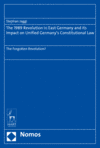The 1989 Revolution in East Germany and its Impact on Unified Germany's Constitutional Law
The Forgotten Revolution?
Abstract
The book promotes a completely new understanding of constitutional lawmaking in Germany. A thorough analysis of the 1989 Revolution in the GDR demonstrates that it is wrong to reduce the Revolution’s meaning to bringing about German unification and an unconditional adoption of West German constitutional law by the new states. Instead, the author shows that the Revolution had its own constitutional agenda, at least parts of which were transferred to unified Germany, where mostly the Federal Constitutional Court integrated them into the West German constitutional order. Case analyses reveal that unified Germany’s constitutional law is a co-production between East German revolutionaries and the old Federal Republic.
The author is Associate Professor of U.S., German, and Comparative Constitutional Law at Peking University School of Transnational Law.
Zusammenfassung
Das Buch fördert ein völlig neues Verständnis für die Entstehung von Verfassungsrecht in Deutschland. Eine eingehende Analyse der 1989er Revolution in der DDR zeigt, dass deren Bedeutung zu Unrecht auf die Herbeiführung der deutschen Wiedervereinigung und eine bedingungslose Übernahme westdeutschen Verfassungsrechts in den neuen Bundesländern reduziert wird. Statt dessen führt der Autor aus, dass die Revolution eine eigene verfassungsrechtliche Agenda hatte, von der zumindest Teile ins wiedervereinigte Deutschland hinübergerettet wurden, wo sie dann, zumeist vom Bundesverfassungsgericht, in die westdeutsche Verfassungsrechtsordnung integriert wurden. Anhand von Fallanalysen wird deutlich, dass Verfassungsrecht im wiedervereinigten Deutschland ein Gemeinschaftsprodukt der ostdeutschen Revolutionäre und der alten Bundesrepublik ist.
Der Autor ist Professor für U.S. amerikanisches, deutsches und vergleichendes Verfassungsrecht an der Peking University School of Transnational Law.
- 243–256 Bibliography 243–256
- 257–258 Acknowledgments 257–258

